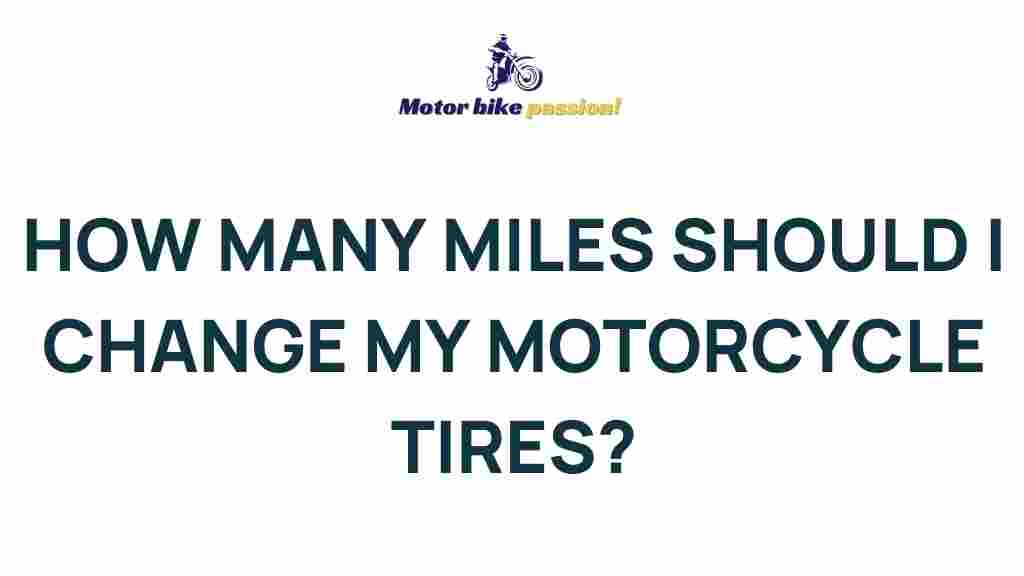Unraveling the Mystery: When Should You Replace Your Motorcycle Tires?
Motorcycle tires are one of the most critical components of your bike. They are your only point of contact with the road and play a pivotal role in your overall safety and performance. Understanding when to replace your motorcycle tires is essential for maintaining your bike and ensuring a safe ride. In this article, we will explore the various factors that contribute to tire replacement, including tread wear, mileage, signs of damage, and general maintenance guidelines. By the end, you’ll have a clearer understanding of how to inspect your tires and determine when it’s time for replacement.
Understanding Motorcycle Tires
Motorcycle tires are designed to provide traction, stability, and comfort while riding. They come in various types, each tailored for specific riding styles such as touring, sport, and off-road. Regardless of your preference, all motorcycle tires share common factors regarding maintenance and replacement.
Why Tire Maintenance is Important
Proper maintenance of your motorcycle tires is crucial for:
- Safety: Worn or damaged tires can lead to accidents.
- Performance: Good tires enhance handling and ride quality.
- Fuel Efficiency: Properly inflated and maintained tires improve fuel economy.
Signs You Need to Replace Your Motorcycle Tires
Identifying the right time to replace your motorcycle tires is vital for your safety. Here are some common signs that indicate it’s time for a replacement:
1. Tread Wear
The tread on your motorcycle tires is crucial for providing grip and traction on various surfaces. Here are some indicators of tread wear:
- Tread Depth: Use a tread depth gauge to measure the tread. A depth of less than 2/32 inches is considered unsafe.
- Tread Indicators: Most tires have built-in wear indicators—if the tread is level with these indicators, it’s time to replace the tire.
- Uneven Wear: Check for signs of uneven wear patterns, which may indicate alignment issues or improper inflation.
2. Age of the Tire
Even if the tread appears fine, age can affect tire performance. Most manufacturers recommend replacing motorcycle tires every 5 to 6 years, regardless of tread wear. Check the tire’s date code, which is usually printed on the sidewall.
3. Damage and Cracks
Inspect your motorcycle tires regularly for visible damage:
- Cracks: Look for cracks or cuts on the sidewalls and tread area.
- Bulges: Any bulging in the tire indicates internal damage and necessitates immediate replacement.
- Punctures: Small punctures may be repairable, but larger ones or those near the sidewall often require a full tire replacement.
4. Vibration and Handling Issues
If you experience excessive vibration or difficulty handling your motorcycle, it could be a sign of tire issues. This could stem from:
- Unbalanced tires
- Worn-out suspension components
- Incorrect tire pressure
Guidelines for Regular Tire Inspection
Regular inspection of your motorcycle tires should be part of your maintenance routine. Here’s a step-by-step guide to help you:
Step 1: Visual Inspection
Start with a thorough visual inspection. Look for:
- Cracks, cuts, or any visible damage
- Foreign objects lodged in the tread
- Signs of uneven wear
Step 2: Check Tread Depth
Use a tread depth gauge to measure the tread. Remember, less than 2/32 inches means you need a replacement.
Step 3: Inspect Tire Pressure
Check your tire pressure regularly using a pressure gauge. The recommended tire pressure can usually be found on the motorcycle’s specifications label or in the owner’s manual.
Step 4: Look for Vibration or Handling Issues
Take your motorcycle for a short ride. Pay attention to any unusual vibrations or handling problems, which could indicate tire or alignment issues.
Step 5: Consult a Professional
If you’re unsure about the condition of your tires, consult a professional mechanic. They can provide a more thorough inspection and offer advice on whether you need a replacement.
Common Myths About Motorcycle Tires
There are several myths surrounding motorcycle tires that can lead to poor maintenance practices. Here are a few:
Myth 1: New Tires Don’t Need Inspection
Many riders assume that new tires don’t need regular checks. However, even new tires should be inspected frequently for proper inflation and damage.
Myth 2: You Can Mix Tire Brands
Mixing tire brands or types can lead to handling issues and is generally not recommended. Always use matching tires on both the front and rear wheels.
Myth 3: Tire Pressure is Not Important
Many riders overlook tire pressure, but it is crucial for safety and performance. Always check your tire pressure before each ride.
Troubleshooting Tips for Tire Issues
If you encounter issues with your motorcycle tires, here are some troubleshooting tips:
1. Addressing Uneven Wear
If you notice uneven wear, check the following:
- Front and rear tire alignment
- Suspension components for wear
- Proper tire inflation
2. Handling Vibration Problems
If your bike vibrates excessively, it could be due to:
- Unbalanced tires: Have them balanced by a professional.
- Worn-out tires: Inspect and potentially replace them.
- Improperly inflated tires: Ensure you’re within the manufacturer’s recommended pressure.
3. Dealing with Punctures
For small punctures, you may be able to use a tire plug or sealant. However, for larger punctures or damage near the sidewall, replacement is usually necessary.
Conclusion: Prioritizing Safety with Motorcycle Tire Maintenance
Maintaining your motorcycle tires is essential for safe riding. Regular inspections for tread wear, damage, and proper inflation will help you identify when it’s time for a replacement. Always remember that worn or damaged tires can significantly affect your bike’s handling and safety. By following the guidelines outlined in this article, you’ll be better equipped to ensure your motorcycle tires are in optimal condition.
For more detailed information on motorcycle maintenance, check out our maintenance guide.
Additionally, for expert advice on motorcycle tires and safety, refer to resources like the Motorcycle Safety Foundation.
This article is in the category Maintenance Tips and created by MotorBikePassion Team
